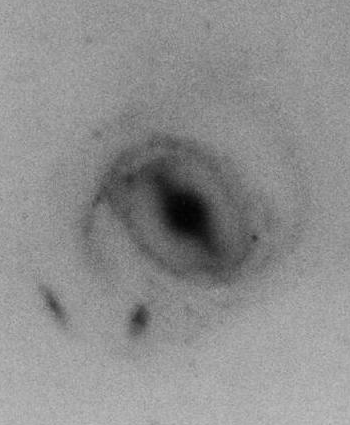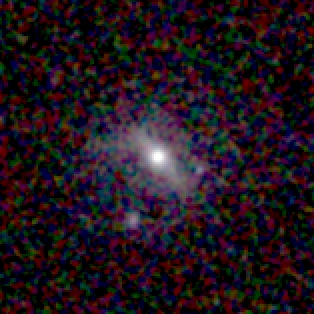 UGC 892 and its companion 2MASXI J0121174-003312 were first listed as Arp 67 in Dr. Halton Arp’s Atlas of Peculiar Galaxies published by Caltech in 1966. Unbelievably, the best image I can find today is still the same photograph used by Dr. Arp that was taken by the Palomar Observatory’s famous 200-inch Hale telescope back in 1966, as shown on the left. I cropped the original image a little to fit it on the page but otherwise it is unaltered. The reason I use the term “unbelievably” is that once again I find that decades have passed and I’m expected to believe that no large modern telescope has bothered to make another observation of what is potentially yet another example of discordant redshifts between two possibly connected objects.
UGC 892 and its companion 2MASXI J0121174-003312 were first listed as Arp 67 in Dr. Halton Arp’s Atlas of Peculiar Galaxies published by Caltech in 1966. Unbelievably, the best image I can find today is still the same photograph used by Dr. Arp that was taken by the Palomar Observatory’s famous 200-inch Hale telescope back in 1966, as shown on the left. I cropped the original image a little to fit it on the page but otherwise it is unaltered. The reason I use the term “unbelievably” is that once again I find that decades have passed and I’m expected to believe that no large modern telescope has bothered to make another observation of what is potentially yet another example of discordant redshifts between two possibly connected objects.
This somewhat grainy image shows what appears to be a small companion object just southwest of the primary galaxy UGC 892. The smaller object, 2MASXI J0121174-003312, appears to be disrupting the darker of the two main arms of the larger galaxy making it seem to appear connected to the larger galaxy. Of course the problem with this is that the objects’ redshifts indicate that they are supposedly at great distances from each other and therefore the smaller object could not possibly be affecting the larger one. UGC 892’s redshift of 0.0175 z as listed on NED places it at a supposed distance of approximately 310 million light years from Earth using a so-called Hubble Constant value of 55 (km/s)/Mpc. The redshift of 2MASXI J0121174-003312 is listed on NED as 0.055 z which places it at supposedly three times the distance at approximately 967 million light years from Earth also using a so-called Hubble Constant value of 55 (km/s)/Mpc.
 One would think that such a discrepancy would garner a closer look by one of the several larger telescopes that have been built since the Hale in the past sixty years. Yet the only other observations I could find of Arp 67 were even lower resolution images produced by one-meter range telescopes such as the UK Schmidt and the retired 50-inch telescope at Kitt Peak including a set of infrared images produced by the Two Micron All-Sky Survey (2MASS) over a decade ago and listed under the name 2MASX J01211663-0032402. A composite of the three infrared waveband images taken by 2MASS is show on the right.
One would think that such a discrepancy would garner a closer look by one of the several larger telescopes that have been built since the Hale in the past sixty years. Yet the only other observations I could find of Arp 67 were even lower resolution images produced by one-meter range telescopes such as the UK Schmidt and the retired 50-inch telescope at Kitt Peak including a set of infrared images produced by the Two Micron All-Sky Survey (2MASS) over a decade ago and listed under the name 2MASX J01211663-0032402. A composite of the three infrared waveband images taken by 2MASS is show on the right.
Even in this fuzzy image and in the others mentioned a tenuous connection between the parent and companion objects is visible. Hopefully one day more higher resolution images of these objects will be made available from the powerful telescopes at our disposal and a literally more clearer picture of the situation will emerge even if it does conflict with current cosmological theories. As usual I will continue to pursue new data and report any new findings as they are published. And as always, I encourage all visitors to this site to pursue their own observations and feel free to contribute to those posted here or even submit new ones.
Thanks for reading!
Shannon
